
Table of Contents
When life feels like it’s spinning too fast, grounding techniques can be your anchor. If you’ve ever felt overwhelmed by anxiety, racing thoughts, or a sense of disconnection from your body, you’re not alone. In our fast-paced world, stress can creep in quietly or crash down all at once—but either way, it pulls us away from presence. That’s where grounding comes in: simple, soothing practices that draw us back to our bodies and the moment we’re in.
In this blog post, we’ll dive into the world of grounding techniques—what they are, why they work, and how you can use them to relieve stress and anxiety naturally. Whether you’re new to grounding or looking to deepen your practice, this guide will walk you through everything you need to know. Let’s make space for calm, one grounded breath at a time.
This post may contain affiliate links. I only recommend products and services I genuinely believe in. Additionally, some images on this website may have been created with the help of AI to convey the feeling I wish to share with the reader.
What You Might Need
- A quiet or safe space to practice grounding
- Natural elements like grass, sand, or water
- Essential oils or soothing scents
- Notepad and pen (for mental grounding exercises)
- Comfortable clothing
- A calming playlist or white noise
- A warm beverage or cold item for sensory connection
Understand Grounding: What It Is and Why It Works
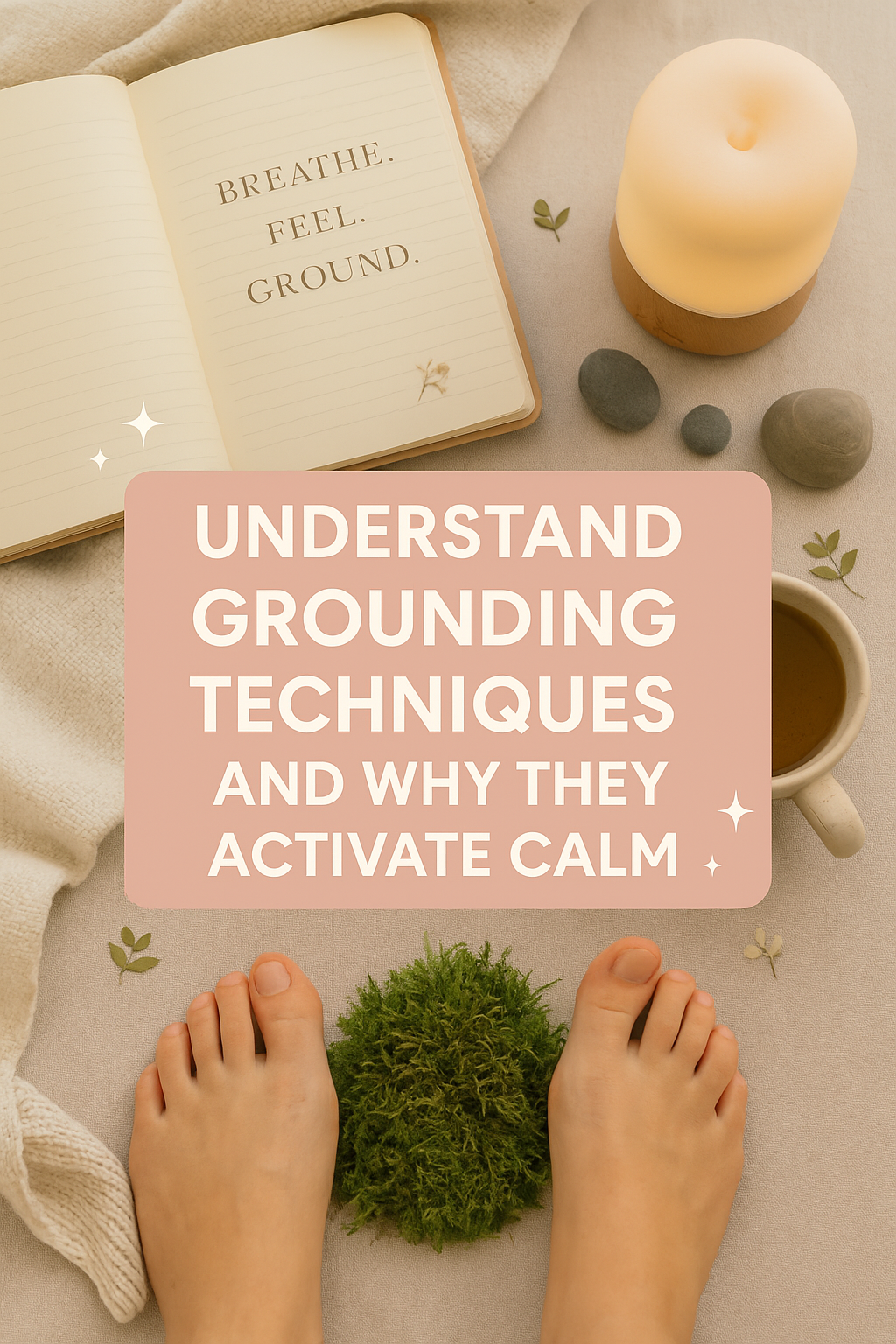
There was a time when I didn’t even know I was disconnected from my body. I just knew I was tired, overwhelmed, and reacting to everything. Once I learned about grounding techniques, things began to shift. Grounding helped me slow down, get clear, and return to a sense of calm that I thought was long gone.
Grounding isn’t just a wellness trend—it’s a proven way to reset the nervous system, bring the mind and body into the same space, and help us reclaim peace. Whether it’s holding an ice cube, putting your feet in the grass, or focusing on your breath, grounding helps you feel safe, settled, and present.
Benefits of Grounding
Grounding techniques activate the parasympathetic nervous system, reducing cortisol and bringing your body back to a calm state.
Enhancing Mind-Body Awareness
By reconnecting with your physical body, grounding helps you escape the mental spiral and become present with your emotions and surroundings.
Pairing Grounding with Breathwork
Combining breath awareness with grounding techniques multiplies their calming effect, creating a full-body reset.
Steps to Practice Grounding Basics
- Begin by identifying a safe, quiet space.
- Choose one grounding technique (physical, mental, or sensory).
- Use your five senses: What can you see, hear, touch, smell, and taste?
- Stay with the experience for 2–5 minutes.
- Practice regularly to make grounding a habit.
The Science Behind Grounding Techniques

When anxiety strikes, it can feel like your mind and body are caught in a storm with no anchor. Grounding techniques offer that much-needed anchor, bringing you back to the safety of the present moment. Understanding the science behind these techniques helps many people approach them with greater confidence. The fascinating thing is how these simple practices can create profound physiological changes in your body’s stress response system.
The mechanisms behind grounding techniques directly address the physiological components of the stress response. When we’re anxious, our sympathetic nervous system – the “fight or flight” response – becomes activated, flooding our bodies with stress hormones. Grounding practices deliberately activate the parasympathetic nervous system – our “rest and digest” mode – creating a biological shift toward calm and balance.
The Neuroscience of Grounding
The effectiveness of grounding techniques is rooted in how our brains process sensory information. When we engage our senses intentionally, we activate the prefrontal cortex, the brain’s executive function center. This activation helps interrupt the amygdala’s fear response, essentially giving our brain something concrete to focus on instead of perceived threats.
How Anxiety Affects the Body
Anxiety manifests physically through increased heart rate, shallow breathing, muscle tension, and digestive issues. Grounding techniques directly counter these physical symptoms by promoting deeper breathing, muscle relaxation, and a slower heart rate. This physical reversal of anxiety symptoms helps break the cycle of panic.
Research-Backed Benefits
Scientific studies have demonstrated that regular practice of grounding techniques can reduce cortisol levels (the primary stress hormone), improve heart rate variability, and increase feelings of well-being. Research from leading institutions shows these practices can be as effective as medication for some people with anxiety disorders.
How to Apply Grounding Science
- Start by identifying your most common anxiety triggers
- Notice your physical symptoms during anxiety episodes
- Select grounding techniques that directly address your symptoms
- Practice regularly, even when not anxious, to strengthen neural pathways
- Track your physiological responses before and after grounding
Grounding Techniques That Really Work for Daily Stress Relief

Some days, we need more than a reminder to breathe. We need something to do with our energy. Grounding techniques give you something tangible to hold onto when anxiety tries to pull you away from the moment. And the best part? Many of these techniques are simple, free, and take just a few minutes.
Here are ten grounding techniques I love to use when life feels a little too loud.
Physical Techniques to Reconnect with the Body
Doing things like walking barefoot or stretching helps you feel solid, present, and grounded in your body.
Mental Grounding Techniques to Anchor Your Thoughts
Mental games like listing categories or naming facts about your surroundings give your mind a healthy, calming focus.
Sensory Grounding to Calm the Nervous System
Using sound, scent, or temperature to stimulate your senses quickly pulls your attention into the now.
Steps to Practice Grounding Daily
- Try the 5-4-3-2-1 sensory exercise when feeling anxious.
- Keep grounding objects nearby (a stone, soft fabric, essential oil).
- Set a daily timer to pause and ground, even for a minute.
- Create a “grounding corner” in your home.
- Combine two or three techniques for deeper calm.
Physical Grounding Techniques for Immediate Relief
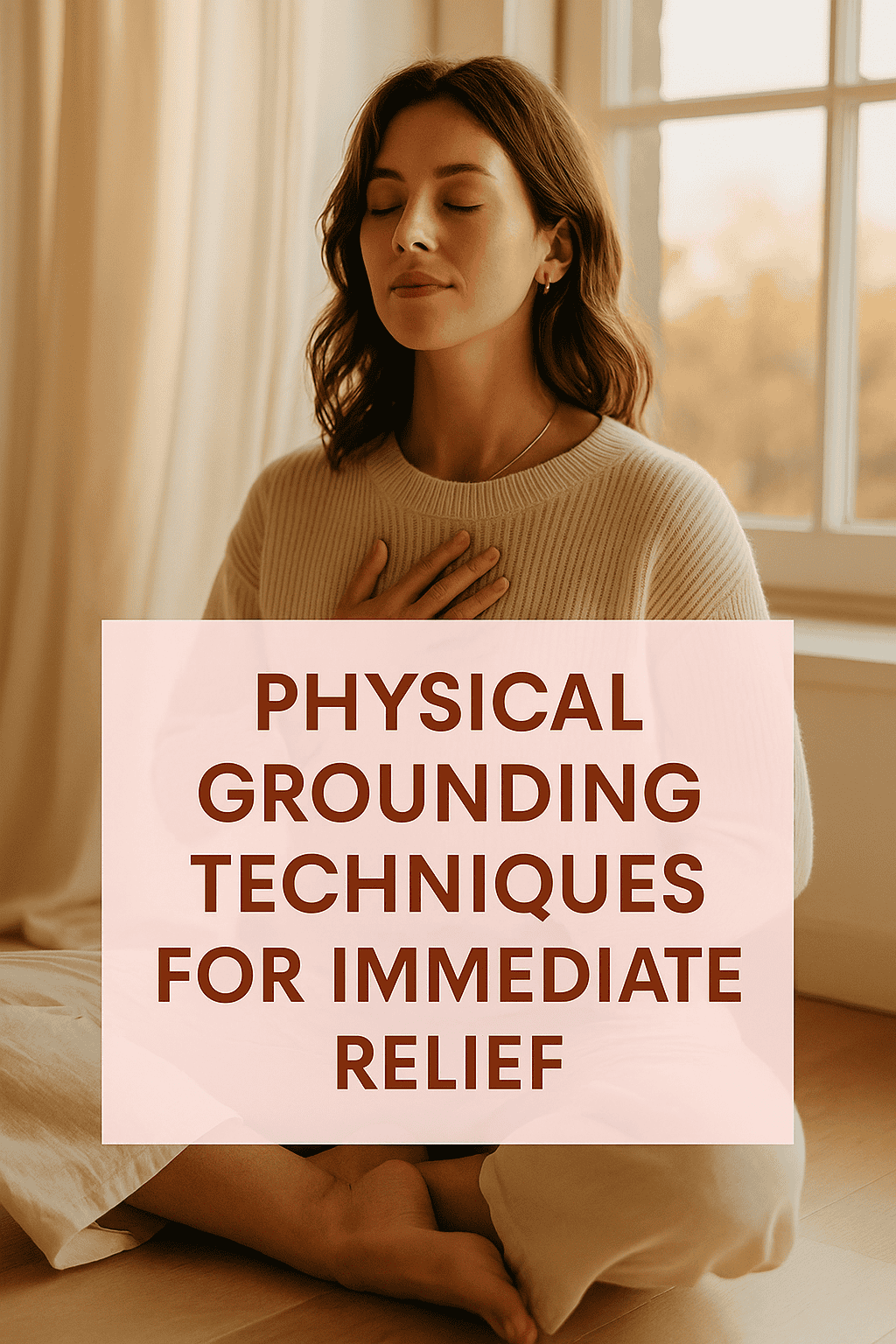
When anxiety hits, our bodies often bear the brunt of its impact through tension, shallow breathing, and that uncomfortable sensation of being disconnected from ourselves. There’s a story about a firefighter named James who struggled with anxiety after a particularly difficult rescue. He discovered that simple physical grounding techniques – like firmly pressing his feet into the ground while taking deep breaths – could help him stay present during stress-triggering situations. His experience highlights how connecting with physical sensations can anchor us during emotional storms.
What’s remarkable about body-focused practices is their accessibility – they don’t require special equipment or extensive training. When your mind starts racing with worries, engaging in deliberate physical movements can serve as powerful reminders that you exist here, now, in this moment and this body. These techniques work by creating strong sensory input that’s impossible for the brain to ignore, effectively pulling attention away from anxious thoughts.
The Power of Physical Sensation
Physical grounding techniques work by creating intense, noticeable sensations that demand your attention. These sensations activate the body’s proprioceptive system – the sense that tells your brain where your body is in space – which helps establish a stronger feeling of being present and connected to reality.
Temperature as a Grounding Tool
Temperature-based techniques like cold water immersion or holding ice cubes create powerful sensory experiences that can interrupt even intense anxiety episodes. The shock of cold temperature stimulates the vagus nerve, which helps regulate the body’s stress response.
Movement for Mental Clarity
Rhythmic, repetitive movements like walking, stretching, or gentle dance create a natural form of meditation that helps synchronize the mind and body. These movements also release muscle tension that accumulates during stress responses.
How to Use Physical Grounding
- For immediate relief, try the “push down” technique: firmly press your feet into the floor while sitting or standing
- Hold an ice cube in your hand or place it against your wrist for 30 seconds
- Try progressive muscle relaxation by tensing and releasing each muscle group
- Practice barefoot walking outdoors on grass, sand, or soil
- Use rhythmic movement like gentle swaying or rocking
Mindfulness-Based Grounding Practices
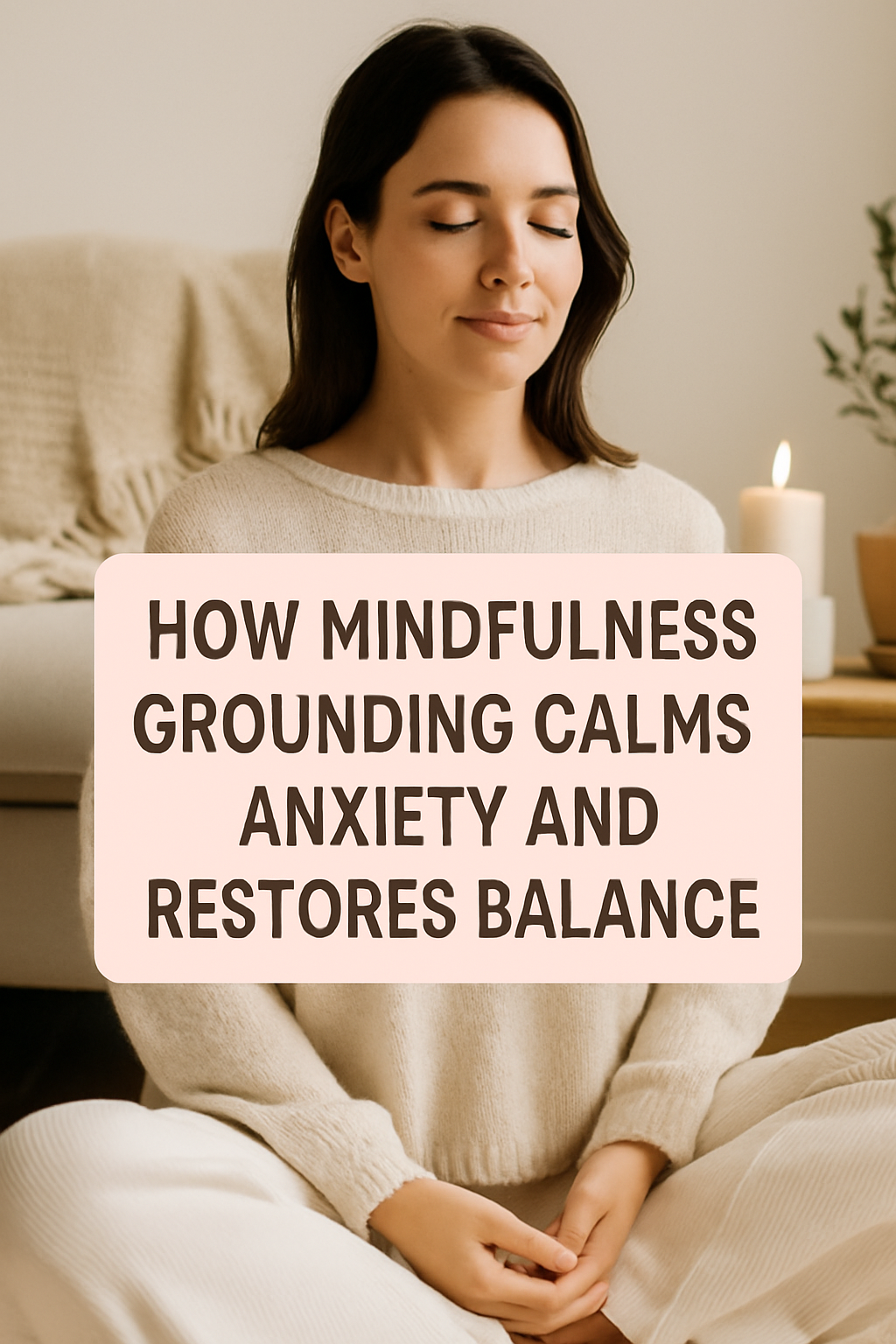
Mindfulness has become something of a buzzword, but its power as a grounding technique is truly transformative. I learned this firsthand while struggling with health anxiety – discovering that observing my thoughts without immediately believing or reacting to them changed everything. This approach to grounding differs from others because it doesn’t try to eliminate anxious thoughts but instead changes our relationship to them.
The core principle of mindfulness—paying attention to the present moment without judgment—offers a gentle yet powerful way to ground ourselves during anxiety. When we practice mindfulness regularly, we develop the ability to recognize when we’re being carried away by anxious thoughts and can more easily return to the anchor of the present moment. Even brief mindfulness practices throughout the day can help maintain a sense of groundedness.
Mindfulness vs. Meditation
While related, mindfulness and meditation are distinct practices. Mindfulness can be practiced anytime during daily activities, while meditation typically involves dedicated time for practice. Both serve as excellent grounding techniques that develop awareness of the present moment.
Body Scan for Physical Awareness
The body scan technique involves systematically directing attention through different parts of the body, noticing sensations without trying to change them. This practice builds interoception—awareness of internal bodily sensations—which helps identify anxiety symptoms earlier.
Informal Mindfulness Practices
Mindfulness doesn’t require sitting in meditation. Everyday activities like washing dishes, walking, or eating can become powerful grounding practices when done with full attention to sensory experiences and present-moment awareness.
How to Practice Mindful Grounding
- Start with a simple 3-minute daily mindfulness practice focusing on your breath
- Try “noting” by mentally labeling thoughts as they arise (“planning,” “worrying,” etc.) and returning to your anchor
- Practice a 5-minute body scan, moving attention from feet to head
- Choose one routine activity daily to perform mindfully with full attention
- Use “micro-practices” (10-20 seconds of mindfulness) throughout your day
The 5-4-3-2-1 Sensory Grounding Method
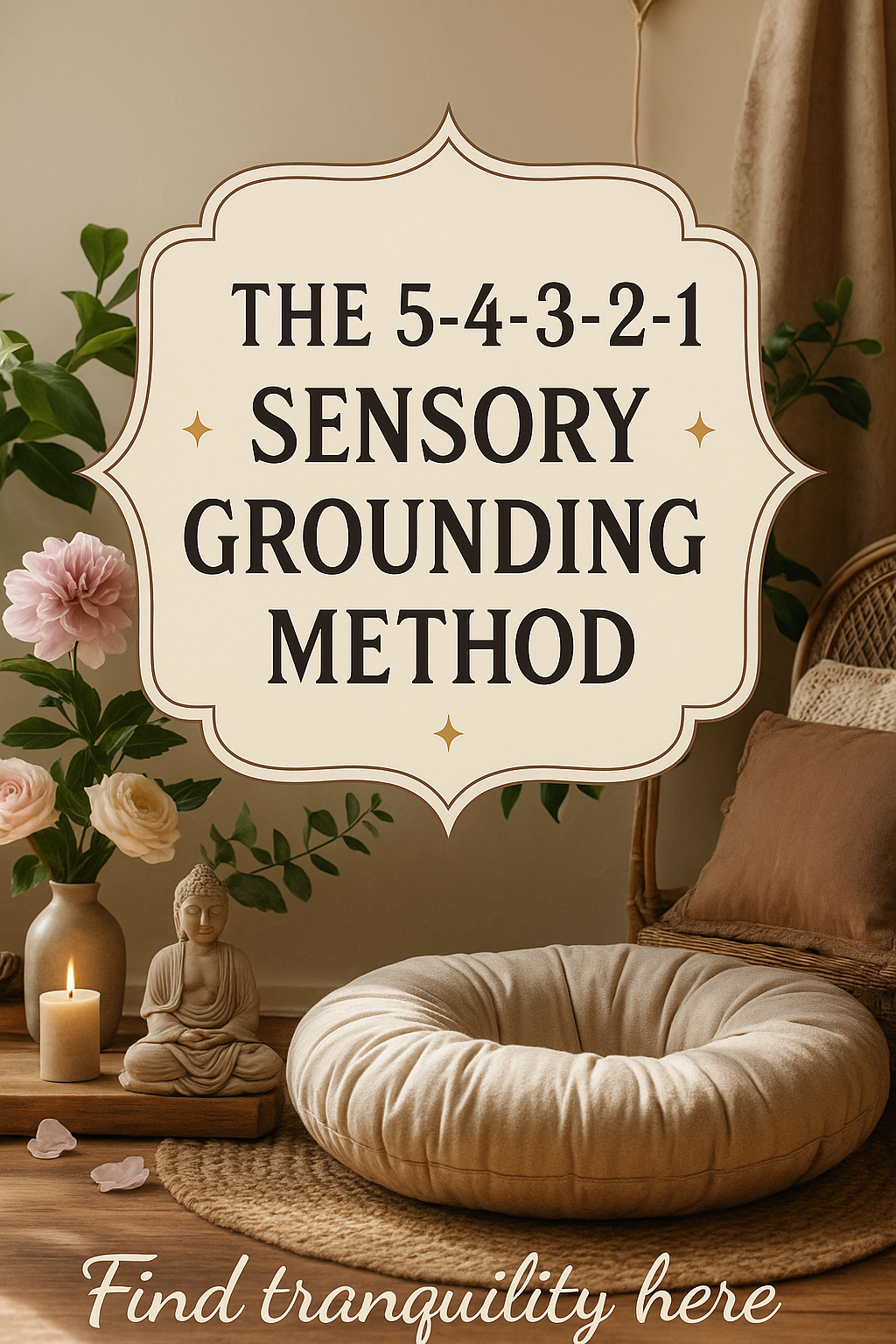
I discovered the 5-4-3-2-1 technique during a particularly challenging period of anxiety, and it quickly became my go-to method for regaining balance. What makes this technique powerful is its simplicity and accessibility – you don’t need any special equipment or even a quiet space to practice it. I’ve used it everywhere from crowded subways to important meetings when I feel disconnect or overwhelm beginning to rise.
When we systematically engage each of our senses, we create a strong tether to the present moment. This technique works by redirecting attention away from distressing thoughts and toward concrete, observable aspects of the immediate environment. Many people find this technique particularly helpful when their minds are racing with worst-case scenarios or caught in rumination spirals.
How the 5-4-3-2-1 Technique Works
The 5-4-3-2-1 method engages all five senses in descending order. Begin by acknowledging five things you can see, then four things you can touch or feel, three things you can hear, two things you can smell, and one thing you can taste. This sequential engagement helps your brain shift from emotional processing to sensory awareness.
Adapting for Different Situations
One of the greatest strengths of this technique is its flexibility. It can be practiced discreetly in public settings like crowded meetings or busy stores. You can also modify the order or number of sensory inputs based on personal preferences or immediate needs.
Enhancing with Mindful Attention
The effectiveness of this technique multiplies when paired with mindful attention. Rather than rushing through the steps, take time to fully experience each sensory observation. Notice details, textures, and qualities of each item you identify.
Steps to Practice the 5-4-3-2-1 Method
- Find a comfortable position, either seated or standing
- Begin by taking three deep, slow breaths
- Identify 5 things you can see around you (notice colors, shapes, and details)
- Acknowledge 4 things you can physically feel (your clothing, the temperature, etc.)
- Listen for 3 distinct sounds in your environment
- Identify 2 things you can smell (or like to smell)
- Notice 1 thing you can taste (or like to taste)
- Finish with another deep breath
How to Create a Personal Grounding Routine That Actually Helps
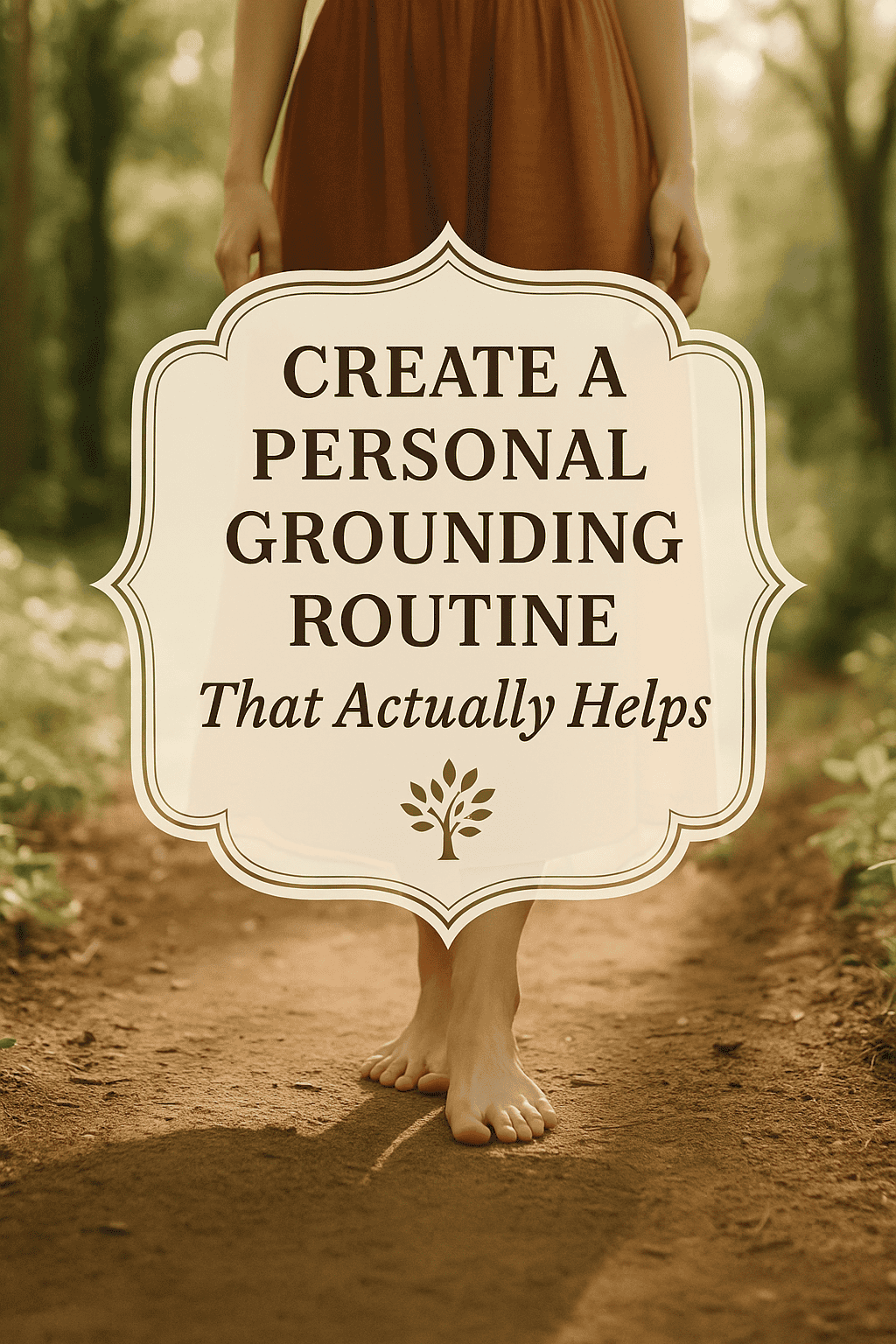
Grounding becomes even more powerful when it becomes yours. It’s not about copying someone else’s method but finding what truly supports you. For me, it’s standing barefoot on the earth with a warm drink and deep breaths. That simple practice gives me clarity and peace, even on chaotic days.
Creating a personal grounding routine helps you stay calm, focused, and emotionally steady, even when life throws curveballs. It becomes your go-to reset—and you deserve that kind of support.
Benefits of a Custom Routine
Tailoring your grounding ritual helps ensure consistency and long-term benefits by fitting into your lifestyle.
Enhancing Emotional Regulation
Your daily routine becomes a reliable tool to shift from emotional reactivity to calm awareness.
Pairing Grounding with Journaling
Writing down your thoughts while practicing grounding deepens self-awareness and clarity.
Steps to Build Your Routine
- Identify what time of day you feel most anxious or disconnected.
- Choose 2–3 grounding techniques you enjoy.
- Create a ritual with music, scent, or movement.
- Start with 5 minutes a day and build from there.
- Reflect weekly to adjust based on what works best.
The Science Behind Grounding and Its Healing Power
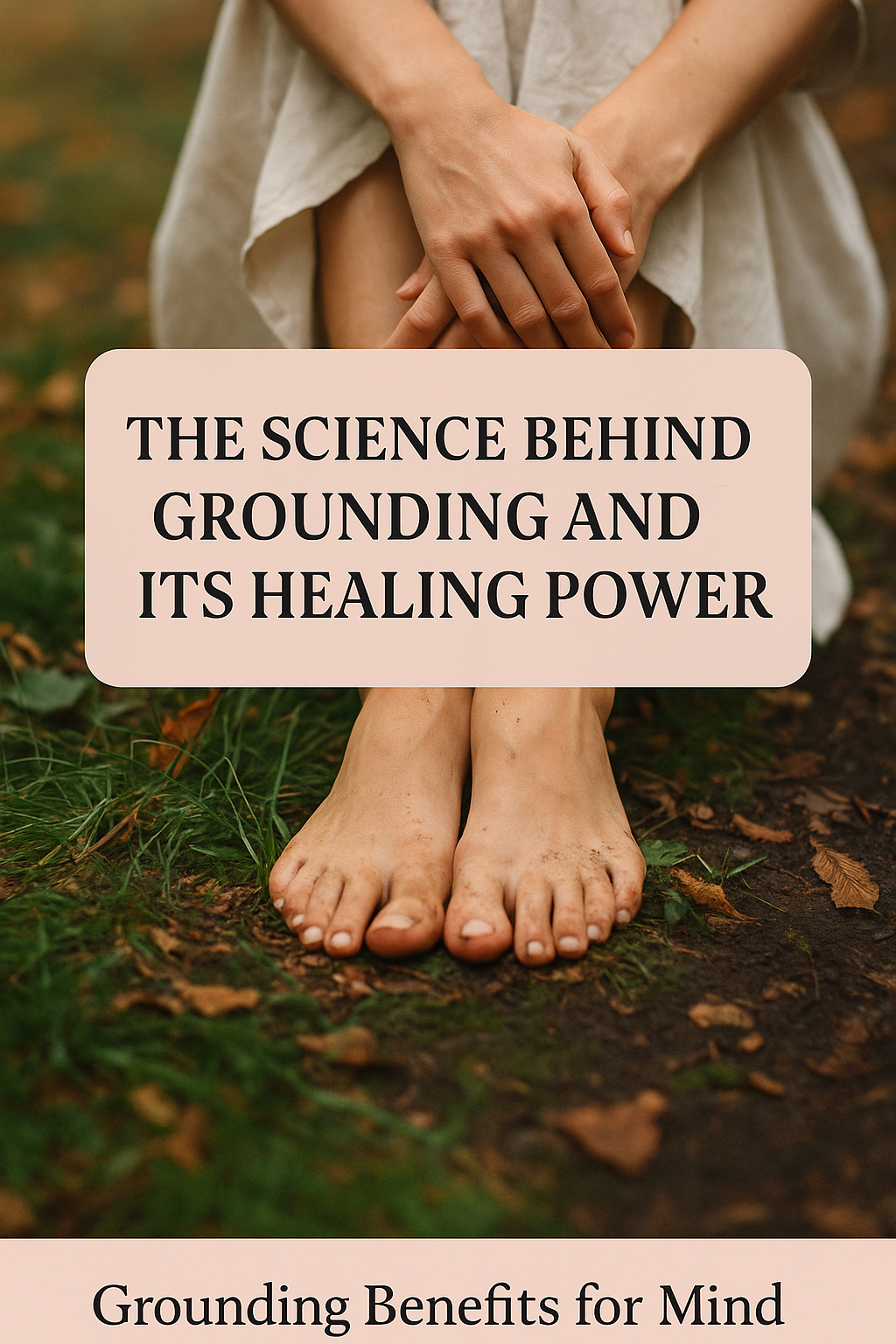
For those of us who love knowing the “why” behind wellness, the science of grounding is fascinating. Research has shown that grounding reduces inflammation, improves sleep, and balances cortisol levels. This isn’t just emotional wellness—it’s physical and neurological too.
I remember reading about a study on grounding and sleep, and realizing my barefoot walks were doing more than just helping my mood. They were healing my body from the inside out. That gave me even more motivation to stay consistent with it.
Benefits of Grounding for Health
Studies show grounding improves heart rate variability, reduces anxiety, and supports immune function.
Enhancing Sleep and Mood
By reducing inflammation and cortisol, grounding encourages deeper sleep and balanced moods.
Pairing Grounding with Nature
Spending time in nature while grounding compounds its effects and strengthens your body’s natural rhythms.
Steps to Add Grounding Science to Your Practice
- Read studies or books on earthing and nervous system regulation.
- Track your mood, sleep, or energy before and after grounding.
- Integrate grounding into your self-care toolbox.
- Stay consistent to experience long-term physiological benefits.
- Share your results or invite a friend to join.
Holistic Wellness: Pairing Grounding with Other Calming Practices
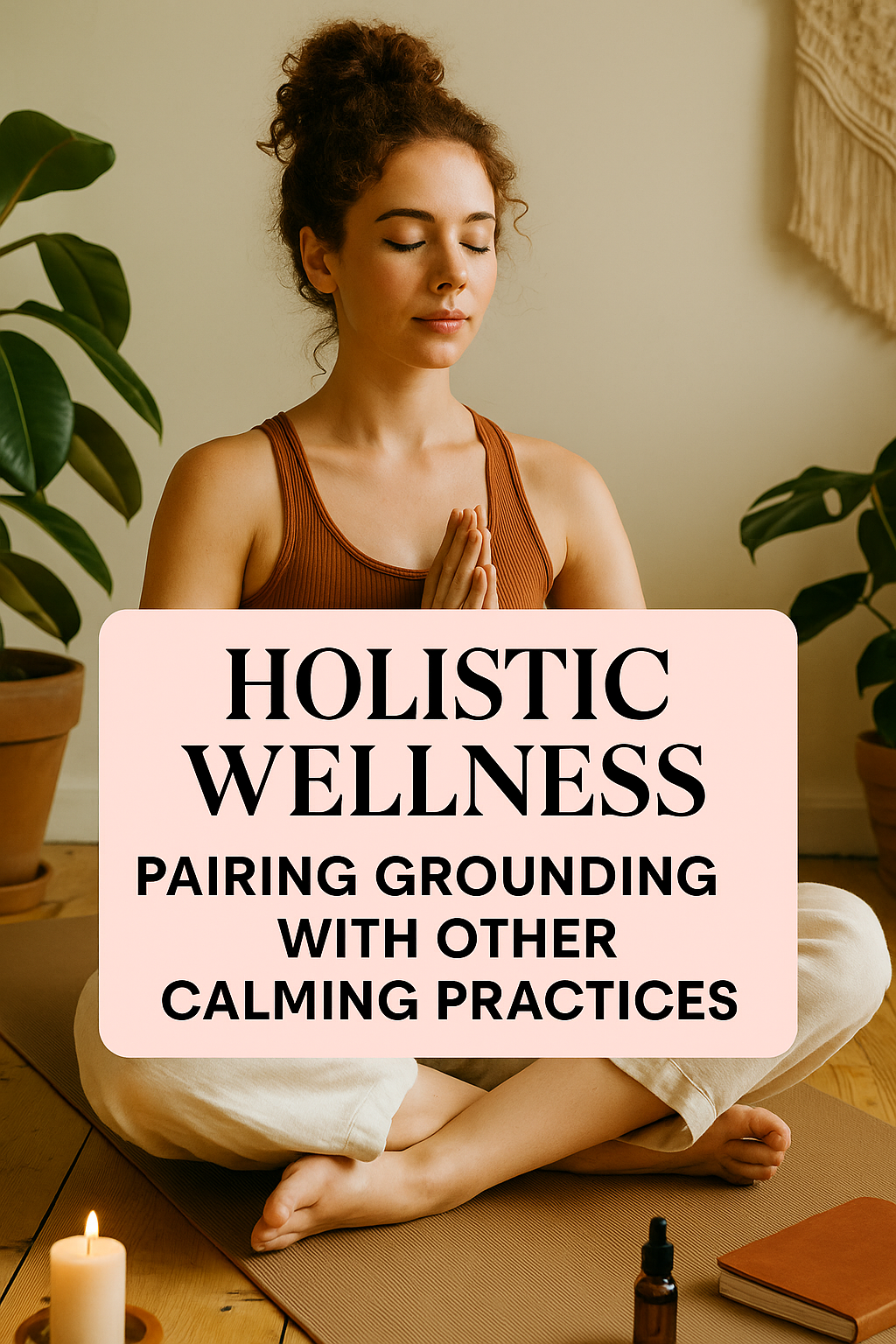
Grounding is powerful on its own—but when paired with other calming tools, it becomes transformative. I often begin my mornings with grounding, breathwork, and a bit of stretching. This combo keeps me energized and emotionally balanced throughout the day.
Whether you’re using grounding for anxiety, focus, or stress relief, layering it with other wellness rituals can enhance its effectiveness. It’s all about creating a flow that feels good for your whole self.
Benefits of Pairing Grounding with Wellness Practices
Combining grounding with other techniques boosts overall emotional resilience and energy.
Enhancing Mindful Living
Grounding encourages intentional habits, helping you stay present and aligned with your goals.
Pairing Grounding with Rituals
Use grounding as the foundation for meditation, intuitive eating, or daily reflection.
Steps to Create a Holistic Ritual
- Choose two complementary practices (like breathwork + grounding).
- Set a dedicated time and space.
- Use props (a yoga mat, oils, journal).
- Keep it simple and enjoyable.
- Repeat regularly to anchor new habits.
Final Thoughts

You don’t need a perfect plan to begin grounding—you just need a moment of intention. Whether you’re dealing with anxiety, burnout, or just need a few minutes to breathe, grounding is your invitation to come home to yourself. These techniques are simple, but their impact is deep. Every time you connect with your body and the present moment, you’re rewiring your nervous system for calm, resilience, and strength.
When grounding becomes part of your wellness lifestyle, it supports everything else you do. It creates a strong foundation, so you can handle life’s ups and downs with more ease. So the next time you feel overwhelmed, take a breath, plant your feet, and let grounding guide you back to peace.
This post may contain affiliate links. I only recommend products and services I genuinely believe in. Additionally, some images on this website may have been created with the help of AI to convey the feeling I wish to share with the reader.
Frequently Asked Questions
What are grounding techniques?
Grounding techniques are practices that help you connect to the present moment by engaging your senses, body, and environment. They help reduce anxiety, stress, and dissociation by anchoring your awareness.
How often should I use grounding techniques?
Grounding can be used daily or as needed. Many people benefit from incorporating short grounding practices into their morning or evening routines, as well as during moments of stress.
Can grounding techniques help with panic attacks?
Yes! Grounding techniques are particularly useful during panic attacks. They can redirect your focus from distressing thoughts to the present moment, which helps reduce fear and physical symptoms.
Do grounding techniques work for children or teens?
Absolutely. Grounding techniques can be adapted for all ages. Children often respond well to sensory grounding like holding a favorite object or naming things they see.
What are some quick grounding techniques I can do anywhere?
Try the 5-4-3-2-1 technique, touch a textured object, take a few deep breaths, or name five things you see. These can all be done discreetly and effectively in public spaces.
About The Author
Jahlila is a Transformational Whole Self and Wellness Lifestyle Empowerment Coach, a devoted mother, passionate writer, and a fervent advocate for holistic wellness. She is the creator of The Tri-Sync Method, a comprehensive coaching program designed to help women establish a personalized wellness and self-care lifestyle for enduring total health wellness.
Her journey has transitioned from focusing solely on health and fitness to embracing a broader mission: empowering women through holistic approaches that unite body, mind, and spirit. Jahlila is dedicated to teaching, coaching, writing, and speaking about how wellness intersects with a joyful, balanced life. Her mission is to motivate women to prioritize and achieve their wellness goals, fostering a deep connection between a vibrant lifestyle and true happiness. Ready to reclaim your vitality, achieve mental clarity, and embrace your wellness journey? Explore more at The Tri-Sync Method.Com
Don’t wait another day to start living your healthiest, happiest life. Schedule a Free Discovery Consultation with Jahlila today to explore how The Tri-Sync Method can transform your life. For additional questions or personalized guidance, please visit our Contact Page.

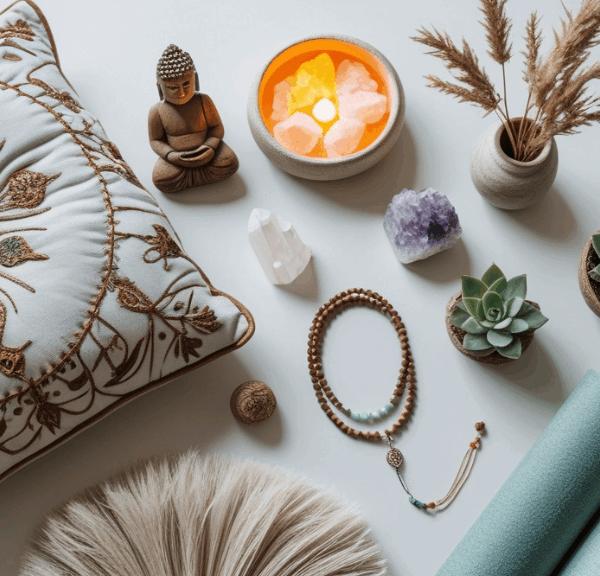
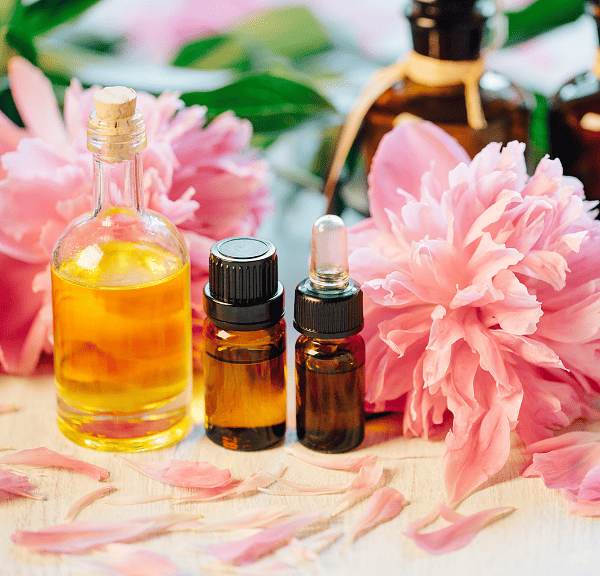
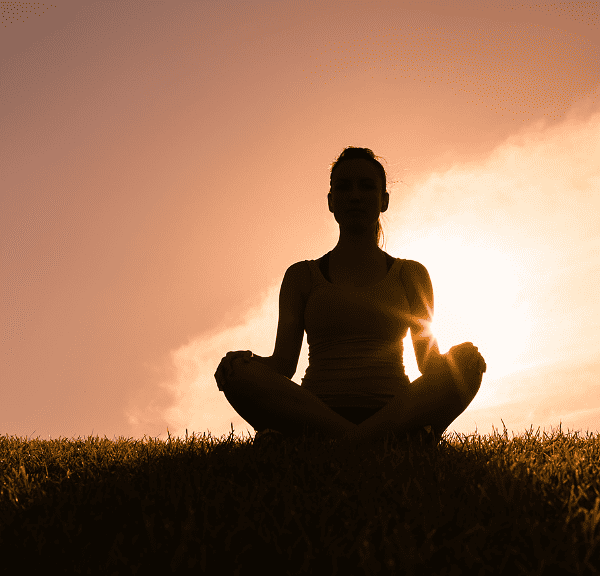
Leave a Reply